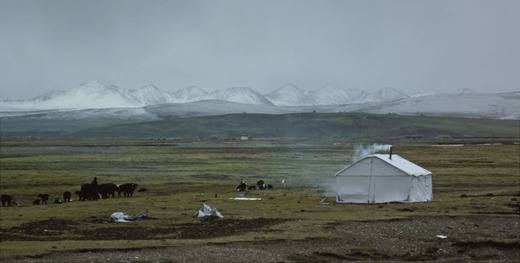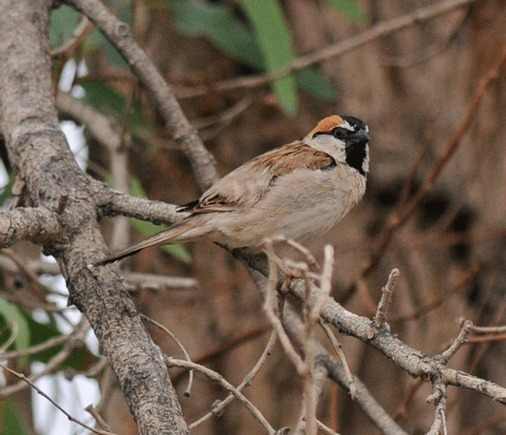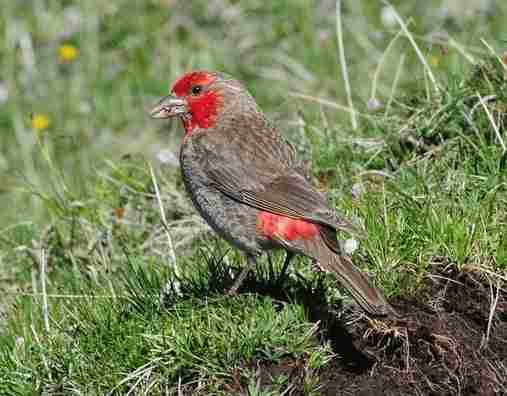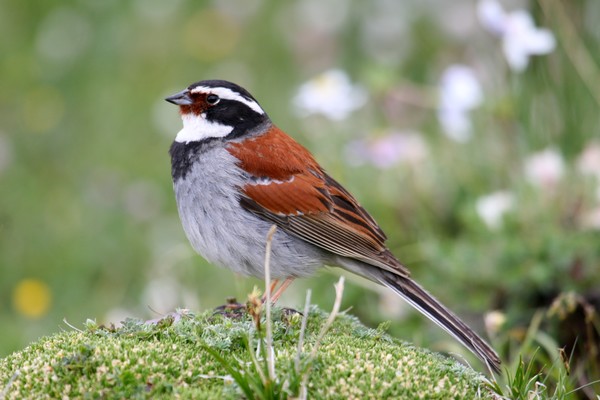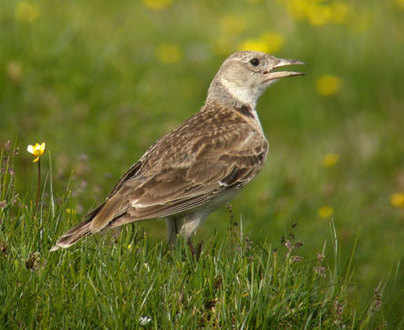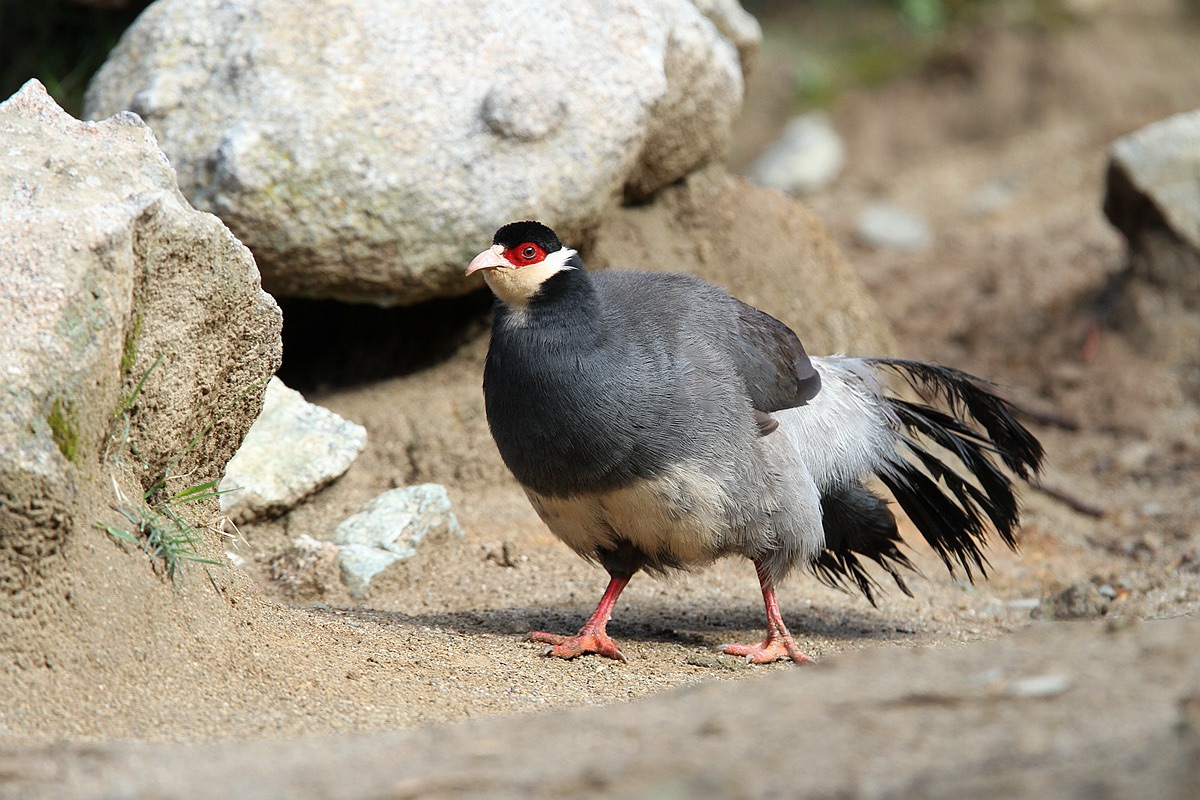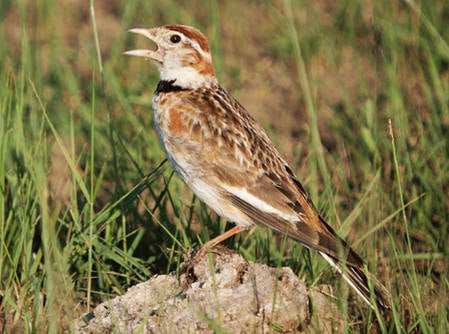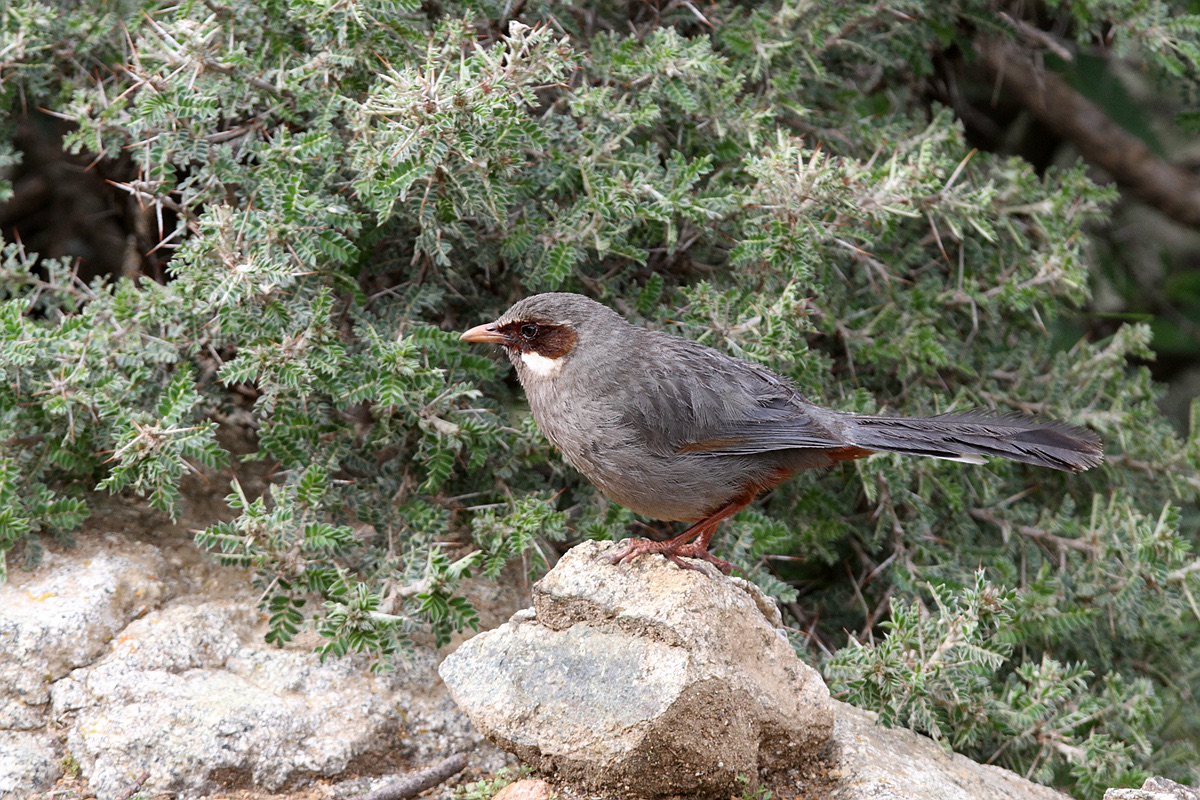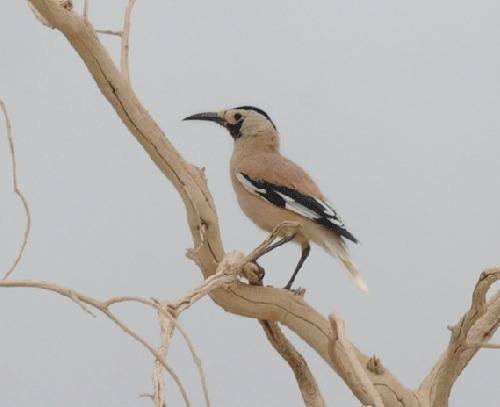DAY 1 ARRIVAL IN XINING - 5th June
Following an overnight flight to Xining via Beijing, we will transfer a short distance to a nearby hotel for an overnight stay.
DAY 2 DONG XIA - HUZU BEI SHAN
An early start with a packed breakfast will see us on the arid slopes of Northern Hill at Xining where we begin by searching for Daurian Partridge, Rufous-tailed Rock-thrush, Pied Wheatear, Pere David’s Laughingthrush, Brown Accentor, Twite, Pale Rosefinch, and both Godlewski’s and Meadow Bunting. Once we have finished here we will drive just under two hours to Dongxia Forest Park and look for our main target, the range-restricted Gansu Leaf-warbler. There are many other great birds to look for such as Eurasian Hobby, Przevalski’s and Chinese Nuthatches, Oriental Skylark, Olive-backed Pipit, Grey-backed Shrike, Chestnut Thrush, Chinese Song Thrush, Elliot's and Plain Laughingthrushes, Siberian Rubythroat, Siberian Stonechat, Crested and White-browed Tit-Warblers, Hume’s and Yellow-streaked Warblers, Rufous-breasted Accentor, Sichuan and Rufous-vented Tits, Asian Azure-winged Magpie, Daurian Jackdaw, Eastern Rook, Large-billed Crow, Grey-capped Greenfinch, White-winged Grosbeak, Common Rosefinch, Grey-headed Bullfinch and Black-faced Bunting. Later in the afternoon we will carry on to Huzhu Bei Shan for a 2-night stay.
DAY 3 HUZU BEI SHAN - HEIMAHE
We will depart very early from our hotel and then spend the morning birding around the forested mountains, high pass and conifer-cloaked valleys not far from the border between Qinghai and Gansu provinces. Our primary targets are a couple of superb Chinese endemics, the beautiful Blue Eared-Pheasant and the very shy Severtzov's (Chinese) Grouse, both of which will take some time to find. This great area also holds Blood Pheasant, Black Woodpecker, White-throated and Hodgson’s Redstarts, Slaty-backed Flycatcher, Chinese, Claudia's and Large-billed Leaf-warblers, Chestnut and Kessler's Thrushes, Spotted Bush-warbler, Grey-crested Tit, Godlewski's Bunting and Grey-headed Bullfinch amongst others. It is interesting to note that the Northern Red-flanked Bluetails in this area are a little different and are a potential future split. Once we are finished here we can drive above the treeline and into more open habitat where species such as Blue-fronted Redstart, Siberian Rubythroat, Greenish Warbler, Alpine Leaf-Warbler, White-browed Tit, Streaked, Chinese Beautiful and Chinese White-browed Rosefinches can be found. Once we are finished here we will drive before heading higher up to the edge of the Tibetan Plateau where we shall find ourselves amidst a vast, open landscape of grassy plains and low, rolling hills. to our next hotel in Heimahe for an overnight stay.
DAY 4 KOR KOR LAKE - HEIMAHE
We will take a packed breakfast with us this morning and drive west to Rubber Mountain (3700m) where we will search for one of the most important species of the entire tour, Pink-tailed Finch, which is a species in a family all of its own! Also amidst the slopes and valleys of this area we hope to see Saker, Mongolian, Crested, Horned and Hume’s Short-toed Larks, Wallcreeper, Blue-fronted Redstart, Hume’s Ground-tit, Alpine Leaf-warbler, Smoky Warbler, White-browned Tit, Rufous-necked, White-rumped and Tibetan Snowfinches, Rosy Pipit, Rock Sparrow, Twite, Mongolian Finch and both Rufous-breasted and Robin Accentors. After most of the morning here we will go to the huge Kor Kor Lake (3200m), one of the largest lakes in Asia and should have plenty of time to explore the eastern edge for such goodies as Black-necked Crane, Pallas's Gull, Hume’s Short-toed Lark, Tibetan Lark, Pale Martin, and both Pere David’s and Blanford’s Snowfinches. There will be numerous other species such as Black-necked Grebe, Greylag and Bar-headed Geese, plenty of familiar wildfowl, Chinese Spot-billed and Ferruginous Ducks, Red-crested Pochard, Kentish Plover and other waders, Pallas’s and Brown-headed Gulls, Yellow Wagtail and Isabelline Wheatear. Other common species in this habitat include Black-eared Kite, Hill Pigeon, more than likely our first Mongolian Lark, Horned Lark, Richard’s Pipit, Hume’s Ground-tit and the first of many White-rumped and Rufous-necked Snowfinches. We wil also hope to find Przevalski's Gazelle in this area as well. Once finished here, we will drive to Chaka for a 3 night stay.
DAYS 5 - 6 CHAKA
We will make early starts each morning and head further west to the mountains near Chaka (up to 3950m) in search of the endemic Przevalski’s Partridge and the stunning endemic Ala Shan Redstart, both of which are endemic to this corner of China. There should also be Tibetan Snowcock present here and occasionally Himalayan Snowcock has been seen as well. The habitat at lower elevations contrasts starkly with the surrounding mountains, as we will find ourselves in a semi-desert environment searching for Pallas’s Sandgrouse and the amazing Henderson’s Ground-Jay. Other species here include Xinjiang and Tibetan Grey Shrikes, Wallcreeper, White-winged Grosbeak, Mongolian Finch, Blanford’s Snowfinch and Pine Bunting.
DAY 7 CHAKA - ER LA SHAN - WENQUAN
This morning we will head south to Wenquan, which will enable us to pick up any species we still need for our lists so far. We can make a stop at the edge of Gonghe town as this can be good for a few species such as Eurasian Wryneck, Rufous-tailed Rock-thrush, Eurasian Hoopoe, Tibetan Wagtail, Asian Azure-winged Magpie, Mongolian Finch, Meadow and Black-faced Buntings, as well as the interesting Margellanic Whitethroat. The whole drive today is truly spectacular as the road eventually crosses the awe-inspiring Er La Pass at 4500m and we will find ourselves surrounded by a majestic panorama of snow-capped mountains, where on our last visit we were lucky to find the scarce Pallas's Cat. There should be a little time to check out the vicinity for Guldenstadt’s Redstart, Tibetan Rosefinch, Brandt's Mountain Finch and others before heading to a basic guesthouse. Night at Wenquan.
DAY 8 ER LA SHAN
Today is a very special one as we will be birding amidst the spectacular scenery at Er La Pass for two very important birds: Tibetan Sandgrouse and Roborovski’s (Tibetan) Rosefinch. It will be a long, slow hike up to 4850m to the top and the scree-slope area to look for these very special birds, but there’s plenty of other good species here as well. We may well also find Tibetan Snowcock, Guldenstadt’s Redstart, Prince Henri’s Snowfinch, and both Brandt’s and Plain Mountain Finches in the vicinity. Night at Wenquan.
DAY 9 ER LA SHAN - MADUO
We can spend the morning searching for any bird or mammal species here before driving a few hours to Maduo for an overnight stay, but will pass through good habitat for a number of species including Hill Pigeon, Little Owl, Eurasian Wryneck, Salim Ali’s Swift, Mongolian Lark, Desert Wheatear, Rock Sparrow, Pere David’s, Rufous-necked and Tibetan Snowfinches, Mongolian and Desert Finches, and both Pine and Black-faced Bunting. The drive to Maduo can be good for mammals with species such as Woolly Hare, Kiang, Tibetan Gazelle and there could also be some Blue Sheep. Our last visit recorded a hunting Wolf as well. Night at Maduo.
DAY 10 MADUO - YUSHU
We continue our journey in a southwesterly direction to Yushu, searching along the way for Spotted Great Rosefinch, before crossing a seemingly endless expanse of grassland/steppe where raptors are numerous. We should see many Upland Buzzards, Black-eared Kites, Himalayan Griffons, Lammergeier and Saker. We will take time to search the rivers and marshes of the Huang He for Ibisbill, there’s also a chance of Pallas’s Fish-eagle as well, and there’s plenty of other birds here such as Ruddy Shelducks, Lesser Sandplover, tibetana Common Terns, Salim Ali's Swift, Tibetan Lark, Tibetan Wagtail, Asian House-Martin and many others. One secret high pass often holds Siberian Rubythroat and Streaked Rosefinch as well, before we descend to the town of Yushe for 3 night stay.
DAYS 11 - 12 SNOW LEOPARD QUEST
We have set aside two full days in an area of rocky mountains to search for Snow Leopard. Seemingly every Yak herder in these parts has video footage of the leopards on their cell phones, so it would seem out chances of finding one are reasonable. And when you consider this area has possibly the highest density of Snow Leopards on earth then you could say we are quite optimisitic! We have special permission to enter this area and by painstkingly scanning endless ridges and mountainsides we hope to catch a glimpse of this rare, apex predator. There are no guarantees of course and it definitely won't be easy! Whilst searching at an altitude between 3,800m and 4,800m we could well come across some of the other mammals that inhabit this wild area such as Pallas's Cat, Wolf, Lynx, Tibetan Fox, White-lipped Deer and Glover's Pika to name just a few. There will also be plenty of opportunities to find any new birds we still need for our lists, or just get better views previously seen species. Nights in Yushu.
DAYS 13 - 14 YUSHE - NANGQIAN - KANDE SHAN
Today we drive to Nangqian, passing through yet more incredible scenery and this will give us the opportunity to explore a scenic gorge that has been a reliable spot for Ibisbill, if we still need it! We may well pass family groups of Black-necked Cranes during our journey today, as well as Saker, Upland Buzzard, Kessler’s Thrush, possibly Spotted Great Rosefinch, Pink-rumped Rosefinch, and there’s a decent chance of seeing Kiang (Tibetan Wild Ass). We will spend the following day around Kande Shan Pass (4600 – 4800m) and gorge for the important Tibetan Plateau endemics, Kozlov’s (Tibetan) Bunting and Kozlov’s Babax. Other possibilities here and in some nearby sheltered forested valleys include Tibetan Partridge, Tibetan Snowcock, Szecheny's Monal-Partridge, White Eared-Pheasant, Golden Eagle, Himalayan Griffon Vulture, Lammergeier, Grandala, as well as Snow Pigeon, Wallcreeper, White-capped Redstart, Alpine Leaf-warbler, Greenish Warbler, White-browed Tit, Red-fronted, Chinese Beautiful and Streaked Rosefinches, and both Alpine and Robin Accentors. Lower down in the valley we can search for Eurasian Eagle-Owl, Elliot’s Laughingthrush, weigoldi Dusky Warbler, Crested Tit-warbler, White-browed Tit-warbler, Streaked and Pink-rumped Rosefinches and White-winged Grosbeak. Nights at Nangqian.
DAY 15 BEIZHA FOREST
We will spend the full day at Beizha Forest (3900m), which will mean switching to four-wheel drive cars to negotiate the rough terrain. Here we will primarily look for Szechney’s Monal-Partridge if we still need it and Kozlov’s Babax, but other quality birds include Blood Pheasant, White Eared-Pheasant, Salim Ali’s Swift, Himalayan Bluetail, Giant Laughingthrush, Sichuan Leaf-warbler, Crested Tit-Warbler, Three-banded and Streaked Rosefinches, Tibetan Siskin and both Brown and Maroon-backed Accentors. There’s a fine supporting cast here also, with Three-toed, Grey-headed and Black Woodpeckers, Rosy Pipit, White-tailed Rubythroat, White-bellied Redstart, Long-tailed Thrush, Slaty-backed Flycatcher and Grey-crested, Sichuan and Japanese Tits, Hodgson’s Treecreeper, Black-streaked Scimitar-babbler, Chinese Fulvetta, Hume’s Warbler, White-winged Grosbeak, Tibetan Siskin, Rufous-breasted Accentor, Grey-headed Bullfinch, Chinese White-browed Rosefinch and Maroon-backed Accentor amongst others. Night at Nangqian.
DAY 16 BEIZHA - QUMALAI
Mainly a long travelling day as we drive to Qumalai for an overnight stay, but with a few birding stops along the way if we see something worth investigating. It could also be an interesting day for mammals with Tibetan Fox, Grey Wolf, Tibetan Antelope and Kiang possible as we drive across the wide open plains of the Tibetan Plateau. Night at Qumalai.
DAY 17 QUMALAI - BUDONGQUAN
We will spend the day exploring one of the remotest regions on the Tibetan Plateau looking for some of the rarer mammals such as Pallas's Cat or any birds we still need. In this far flung corner who knows what we will find? Night in Budongquan.
DAY 18 QUMALAI - WILD YAK VALLEY - GOLMUD
Another early start will see us continue our journey across the Tibetan Plateau and through some of the remotest areas of the tour before joining the main Qinghai-Tibet highway at Budongquan. This will be our back-up site for Tibetan Sandgrouse if we missed it erlier at Er Lan Shan. We should stay observant for mammals today as there are more opportunities to see Kiang and Goitered and Tibetan Gazelles, with this being our best bet for Tibetan Antelope of the entire tour and a chance at finding a truly Wild Yak in the appropriately named Wild Yak Valley. By mid-evening we should have reached Golmud where we board the overnight sleeper train to Lhasa in the Tibetan Autonomous Region.
DAY 19 ARRIVAL IN LHASA
We are scheduled to reach Lhasa in the late afternoon and will check-in to our hotel before exploring the surrounding area. Night in Lhasa.
DAYS 20 - 21 LHASA
We have one day birding and one day sightseeing in this magical place. On one day we will visit a nearby monastery for one of the major taret birds of the entire tour - Tibetan Eared-Pheasant. In the immediate vicinity we should find Prince Henri's (Brown-cheeked) Laughingthrush, Giant Babax, Tibetan Blackbird, Streaked Rosefinch, Brown Accentor, Severtzov's Tit-Warbler and Red-billed Chough. We will then spend some time sightseeing and visit the incomparable Potala Palace, which still stands as the main symbol of Buddhist Tibet and is an experience not to be missed. Nights in Lhasa.
DAY 22 LHASA - BEIJING - END OF MAIN TOUR - 26th June
Morning flight to Beijing and end of the main tour.
XINJIANG EXTENSION: 26th June - 30th June
DAY 22 LHASA - CHENGDU - URUMUQI - KORLE - 26th June
If continuing with the extension to Xinjiang then we will fly to Chengdu and take a connecting flight to Urumuqi where we will take the short flight to Korle. Overnight in Korle.
DAY 23 TARIM BASIN - TAKLAMAKAN DESERT
Our first stop this morning may well be the Tarim River where we will look for White-winged Woodpecker, Azure Tit, Desert Whitethroat, Saxaul Sparrow and the skulking Tarim Babbler. Then we will drive out into the Taklamakan Desert in search of the range-restricted Biddulph's Ground-Jay. Other birds present i the area include Black Stork, Black-eared Kite, Long-legged Buzzard and others. Night in Korle.
DAY 24 TAKLAMAKAN DESERT - URUMUQI
We will have the whole morning to search for any species still missing from our lists before taking the domestic flight back to Urumuqi. Apartf from the sesert birds we could also visit a lake where on our last visit we saw a variety of terns, as well as Paddyfield and Great Reed Warblers, Masked Wagtail, Isabelline Shrike and much more. it is an interesting site and well worthy of more exploration if time permits. Or we could return to the Taklamakan Desert for further views of Biddulph Ground-Jay. After our flight back to Urumuqi we will transfer the short distance to a nice hotel for an overnight stay.
DAY 25 TIEN SHAN MOUNTAINS
A full day in the Tien Shan Mountains will begin in the lowlands where Bluethroats, Barred Warblers and Red-headed Buntings will be displaying around the esges of the pretty flower-filled meadows. There could well be flocks of Rosy Starlings present, whilst Tawny Pipits, and Turkestan Shrikes should also be present. Moving higher up into the alpine forests and pastures should give us good views of pretty Fire-fronted Serins along the roadside, whilst Spotted Nutcracker, Pied Wheatear, Blue-capped and Eversmann's Redstarts, Pine and Godlewski's Buntings, Black-throated Accentor, Red-mantled Rosefinch are all present. Night i Urumuqi.
DAY 26 END OF TOUR - 30th June
International departures and end of the tour.

